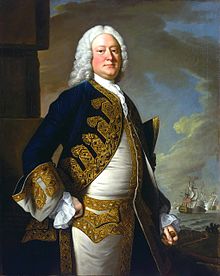John Byng | |
|---|---|
 Portrait of John Byng by Thomas Hudson, 1749 | |
| Born | baptised 29 October 1704 Southill, Bedfordshire, England |
| Died | 14 March 1757 (aged 52) Portsmouth, England |
| Allegiance | |
| Service | |
| Years of service | 1718–1757 |
| Rank | Admiral |
| Commands | Newfoundland Station Leith Station Mediterranean Fleet |
| Battles / wars | |

Admiral John Byng (baptised 29 October 1704 – 14 March 1757)[1] was a British Royal Navy officer who was court-martialled and executed by firing squad. After joining the navy at the age of thirteen, he participated at the Battle of Cape Passaro in 1718. Over the next thirty years he built up a reputation as a solid naval officer and received promotion to vice-admiral in 1747. He also served as Commodore-Governor of Newfoundland Colony in 1742, Commander-in-Chief, Leith, 1745 to 1746 and was a member of Parliament from 1751 until his death.
Byng failed to relieve a besieged British garrison during the Battle of Minorca at the beginning of the Seven Years' War. He had sailed for Minorca at the head of a hastily assembled fleet of vessels, some of which were in poor condition. In the ensuing battle with a French fleet off the Minorcan coast, he was defeated and the fleet under his command considerably damaged. He then elected to return to Gibraltar to repair his ships. Upon return to Britain, Byng was court-martialled and found guilty of failing to "do his utmost" to prevent Minorca from falling to the French. He was sentenced to death and, after pleas for clemency were denied, was shot dead by a firing squad on 14 March 1757.
- ^ Baugh, Daniel A. "Byng, John (bap. 1704, d. 1757)". Oxford Dictionary of National Biography (online ed.). Oxford University Press. doi:10.1093/ref:odnb/4263. (Subscription or UK public library membership required.)